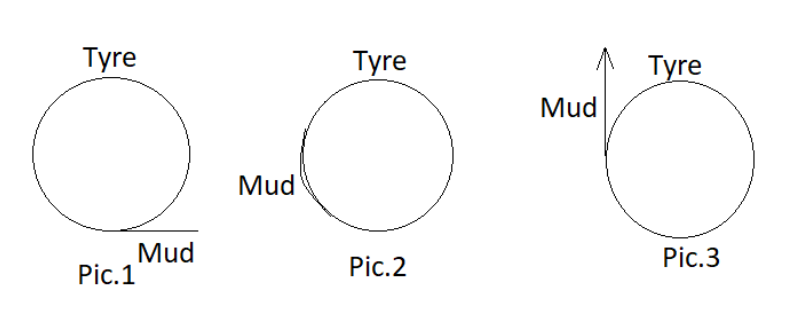
A car travels north with a uniform velocity. It goes over a piece of mud which sticks to the tyre. The particles of the mud are thrown
A. vertically inward
B. vertically upward
C. horizontally to south
D. horizontally to north
Answer
470.4k+ views
Hint: We at first need to think and draw the situation at that point of time how the actual representation will look, after drawing the figure try to analyze what forces could be acting between the mud and the tyre to hold two of them together.
Complete step by step answer:

Here in the above diagram we can see that a piece of tyre is there which is moving clockwise over a lump of mud, now in pic.1 we can see that the tyre is coming in contact with the mud at first. In pic.2 we see that the piece of mud is now with the tyre and moving along with it, in pic 3 we can see that when that part of the tyre is vertically horizontal and in a good force the lump of mud gets thrown away vertically upward.
Now, let is answer the problem, when the car is moving over the piece of mud the mud due to its adhesive nature gets struct with it inside the grooves of the tyres, now when the tyre comes into a horizontal position the grooves contact force and the adhesive force of the mud holds it together now as the tyre passes the horizontal position all the contact forces that were acting were removed and the adhesive nature of the mud is not enough to provide the centripetal force required, which makes the must to leave the type straight along the tangent of the circle at that point.
So, the correct answer is “Option B”.
Note: Adhesive force is a force which generally tries to hold itself with another body, like we use gum to stick two pieces of paper so this stickiness is due to the adhesive force. Centripetal force is the force that acts on the body of a moving object which is moving in a circular path and this force is directed towards the center around which the body is moving.
Complete step by step answer:

Here in the above diagram we can see that a piece of tyre is there which is moving clockwise over a lump of mud, now in pic.1 we can see that the tyre is coming in contact with the mud at first. In pic.2 we see that the piece of mud is now with the tyre and moving along with it, in pic 3 we can see that when that part of the tyre is vertically horizontal and in a good force the lump of mud gets thrown away vertically upward.
Now, let is answer the problem, when the car is moving over the piece of mud the mud due to its adhesive nature gets struct with it inside the grooves of the tyres, now when the tyre comes into a horizontal position the grooves contact force and the adhesive force of the mud holds it together now as the tyre passes the horizontal position all the contact forces that were acting were removed and the adhesive nature of the mud is not enough to provide the centripetal force required, which makes the must to leave the type straight along the tangent of the circle at that point.
So, the correct answer is “Option B”.
Note: Adhesive force is a force which generally tries to hold itself with another body, like we use gum to stick two pieces of paper so this stickiness is due to the adhesive force. Centripetal force is the force that acts on the body of a moving object which is moving in a circular path and this force is directed towards the center around which the body is moving.
Recently Updated Pages
Master Class 11 Accountancy: Engaging Questions & Answers for Success

Glucose when reduced with HI and red Phosphorus gives class 11 chemistry CBSE

The highest possible oxidation states of Uranium and class 11 chemistry CBSE

Find the value of x if the mode of the following data class 11 maths CBSE

Which of the following can be used in the Friedel Crafts class 11 chemistry CBSE

A sphere of mass 40 kg is attracted by a second sphere class 11 physics CBSE

Trending doubts
10 examples of friction in our daily life

Difference Between Prokaryotic Cells and Eukaryotic Cells

State and prove Bernoullis theorem class 11 physics CBSE

What organs are located on the left side of your body class 11 biology CBSE

Define least count of vernier callipers How do you class 11 physics CBSE

The combining capacity of an element is known as i class 11 chemistry CBSE




